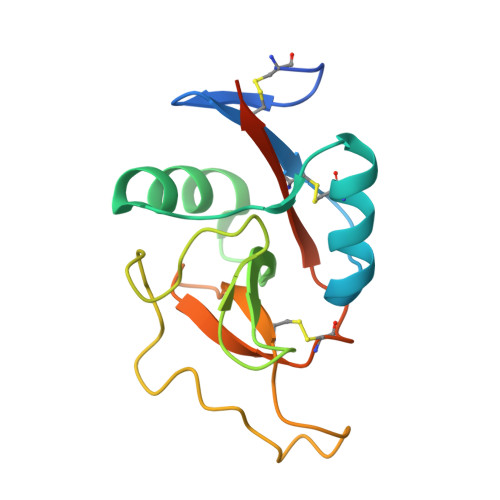Efficient Liver Targeting by Polyvalent Display of a Compact Ligand for the Asialoglycoprotein Receptor.
Sanhueza, C.A., Baksh, M.M., Thuma, B., Roy, M.D., Dutta, S., Preville, C., Chrunyk, B.A., Beaumont, K., Dullea, R., Ammirati, M., Liu, S., Gebhard, D., Finley, J.E., Salatto, C.T., King-Ahmad, A., Stock, I., Atkinson, K., Reidich, B., Lin, W., Kumar, R., Tu, M., Menhaji-Klotz, E., Price, D.A., Liras, S., Finn, M.G., Mascitti, V.(2017) J Am Chem Soc 139: 3528-3536
- PubMed: 28230359
- DOI: https://doi.org/10.1021/jacs.6b12964
- Primary Citation of Related Structures:
5JPV, 5JQ1 - PubMed Abstract:
A compact and stable bicyclic bridged ketal was developed as a ligand for the asialoglycoprotein receptor (ASGPR). This compound showed excellent ligand efficiency, and the molecular details of binding were revealed by the first X-ray crystal structures of ligand-bound ASGPR. This analogue was used to make potent di- and trivalent binders of ASGPR. Extensive characterization of the function of these compounds showed rapid ASGPR-dependent cellular uptake in vitro and high levels of liver/plasma selectivity in vivo. Assessment of the biodistribution in rodents of a prototypical Alexa647-labeled trivalent conjugate showed selective hepatocyte targeting with no detectable distribution in nonparenchymal cells. This molecule also exhibited increased ASGPR-directed hepatocellular uptake and prolonged retention compared to a similar GalNAc derived trimer conjugate. Selective release in the liver of a passively permeable small-molecule cargo was achieved by retro-Diels-Alder cleavage of an oxanorbornadiene linkage, presumably upon encountering intracellular thiol. Therefore, the multicomponent construct described here represents a highly efficient delivery vehicle to hepatocytes.
Organizational Affiliation:
School of Chemistry & Biochemistry, Georgia Institute of Technology , 901 Atlantic Avenue, Atlanta, Georgia 30332, United States.


















